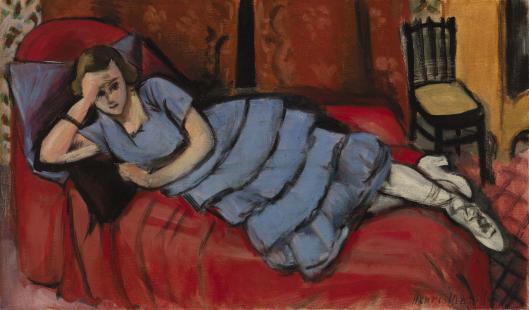Description
Analyzing "The Red Sofa" (Le Canapé Rouge) from 1921, a masterful work by Henri Matisse, is to delve into an experience of color, composition, and emotions that converge in a visual symphony. From the first glance, one is confronted with the strength and vitality of the red sofa that dominates the piece, inviting the viewer to enter a universe where color and shapes are the undisputed protagonists.
At the center of the composition, the robust red sofa radiates an almost tangible presence, vividly contrasting with the more subdued and monochromatic surroundings. This contrast between the sofa and the rest of the environment underscores Matisse's mastery in the use of color, a characteristic that defines much of his work. The red of the sofa is not merely decorative; it is an explosion of energy that guides the viewer's gaze, establishing a central focus around which everything else revolves.
The composition is crafted with great visual elegance. Combining elements of still life and the interior space, Matisse achieves a balance between the domestic and the aesthetic. The space behind the sofa is not precisely defined, giving an impression of indeterminate depth. This spatial ambiguity is a typical feature in many of Matisse's works, suggesting a space that is both real and dreamlike.
A female figure, located to the right of the sofa, adds an additional layer of interest and humanizes the scene. The woman seems to be in a state of contemplative stillness, introducing an element of calm to counteract the intensity of the red color. Her relaxed posture and the serenity of her presence complement the intrinsic structure of the painting. The way her dress flows and drapes over the sofa creates a smooth visual connection between the subject and the object, a device frequently used by Matisse to unify different elements in a coherent composition.
The work does not distinguish a specific use of traditional perspective, a distinctive feature of Matisse's modern style, where the perception of space and form becomes functions of color and line. The inclusion of details like a pair of bare feet peeking out from under the sofa offers an intimacy and a direct connection with the viewer, a window into a daily moment captured with deceptive simplicity.
As part of a series of interior compositions that Matisse developed throughout his career, "The Red Sofa" reflects his persistent interest in the dialogue between color and form and his ability to transform the ordinary into something extraordinary. As in other works from this period, one can see an influence of contemporary movements like Fauvism, in which Matisse was a pioneer.
It is precisely this ability to find beauty and harmony in the mundane that makes "The Red Sofa" such an impactful work. Through his mastery of color and composition, Matisse not only captures a moment in time but also provides the viewer with a visual experience that resonates far beyond what is seen at first glance. It is a testament to his ability to explore the limits of decorative art, where each brushstroke seems intimately thought out to evoke a particular emotion or sensation.
Ultimately, "The Red Sofa" is not simply a representation of a familiar object; it is a celebration of the transformative power of art and a reminder of the profound connection between personal space and artistic expression. Matisse, through this work, invites us to look beyond the obvious and appreciate the intrinsic beauty in the simplest moments of our daily lives.

